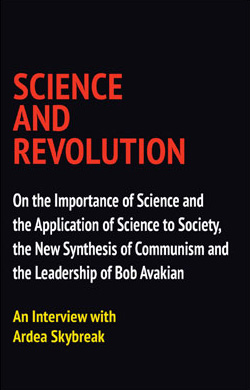Check It Out from a Reader:
The Great Influenza: The Story of the Deadliest Pandemic in History by John M. Barry
| revcom.us
Dear Editors,
I read the book by John M. Barry, The Great Influenza, The Story of the Deadliest Pandemic in History. The 1918 influenza epidemic, after being largely erased from history except for those studying epidemic disease, has become part of the discourse because of its parallels to the coronavirus. In the 1918 epidemic, estimates are that between 50 and 100 million people were killed—most of them in a very short time. And this was bound up with an even more horrific situation, WW 1. What stands out, and which is most decidedly NOT part of the debate and discussion in society generally, is how utterly outmoded and horrific the global system of capitalism-imperialism was then, in 1918, and even more so now, over 100 years later, and how much we need an actual revolution.
Barry’s book starts decades before 1918, and tells the story of the emergence in the second part of the 19th century, first in Europe, and then in the United States, of modern, scientific medicine. Until that time, medicine was a field that still relied on practices and thinking developed originally by the Greeks (the outstanding example is bleeding people to supposedly help them recover from disease—there was no evidence that this worked, it was in fact in most cases harmful, and it had been done for over 2,000 years). On the basis of the overall advance of science in the 19th century, and particularly the theory of evolution, developed by Darwin, there was a series of extremely important scientific advances made which made it possible to begin to take a radically different approach to medicine. Evidence, not theories concocted or taken from the ancients, became central to figuring out what was the problem, and what was the solution in relation to disease. Actual experiments were done to find what caused disease, and the germ theory of disease was developed. Instead of the theory that disease was caused by “miasma” or swamp gas, evidence, rigorously studied and carefully summed up, showed that very small living organisms entered into the body, multiplied, and caused disease. And each disease was caused by a different organism. And this stimulated the development of vaccines and also cures—that were tested, to learn which really worked (or didn’t, so that more work had to be done, as this was a beginning and there was much that was not yet understood). On the basis of these scientific breakthroughs, a battle was waged to transform medical education—to actually require doctors to know chemistry and biology, including the biology of the human body. Part of this involved development and funding of new kinds of hospitals which combined scientific research with patient care.
To give a sense of how things were before this struggle to transform medical education, Barry writes:
[M]ost American medical schools were owned by a faculty whose profits and salaries—even when they did not own the school—were paid by student fees, so the schools often had no admission standards other than the ability to pay tuition. No medical school in America allowed medical students to routinely either perform autopsies or see patients, and medical education often consisted of nothing more than two four-month terms of lectures. Few medical schools had any association with a university, and fewer still had ties to a hospital. (p. 32)
Barry’s book focuses largely on the United States, and he shows how this struggle to transform medicine was backed by a powerful section of the capitalists including John D. Rockefeller. And in some important ways, medicine was transformed. Barry paints a picture of the development of a core of scientist/doctors who saw WW 1 coming, and who set out to make this the first war in which the casualties from disease did not far outnumber the number killed from the war itself. (This touches on some of the weaknesses and limits of the understanding of the scientists of the time—while many of these doctors and scientists had a sense that science should be for humanity, not for this or that nation, at the same time they were focused on reducing U.S. casualties in the war, and tens of thousands of them enlisted in the U.S. Army as the war broke out.)
Ignoring and repudiating science was hardly an invention of the Trump regime—it was stark and egregious in 1918 as well, and is fundamentally rooted in the system of capitalism-imperialism.
World War 1
WW 1 was a huge crime against humanity—it was savage and brutal warfare on a scale never before seen in human history. Horrific trench warfare had gone on for years in Europe by 1918, when the U.S. entered the war. And this was an imperialist war, in which a few European and American capitalist powers fought it out to see which capitalist-imperialist country was going to dominate the world, and especially rule over and exploit vast areas of Asia, Africa, Latin America, and the Middle East. The European capitalist countries, which had by that time dominated the entire world, had considered themselves the epitome of “civilization.” Barry paints a vivid picture of this “civilization”:
In the spring of 1918 death was no stranger to the world. Indeed, by then the bodies of more than five million soldiers had already been fed into what was called “the sausage factory” by generals whose stupidity was only matched by their brutality...
Yet nothing expressed the brutality of this war as did a sanitation report on the planned eradication of rats in the trenches to prevent the spread of disease. A major noted, “Certain unexpected problem are involved in the rat problem.... The rat serves one useful function—he consumes the corpses on No Man’s Land, a job which the rat alone is willing to undertake. For this reason it has been found desirable to control rather than eliminate the rat population.”
Given the incredible degree of ravaging of life and health from the war, in some ways it is not a surprise that a major epidemic swept the planet. But this was not inevitable; it was the result of particular chance mutations in the flu virus, and the interaction of the virus with human society at a particular moment. And the virus continued to mutate and went through three waves. The epidemic of 1918-1919 swept through the armies, then the civilian populations—raced around the world, and then came back two more times. It was bad the first time, the second time it was the deadliest flu ever, and the third wave was not as bad. The virus, and its changes, interacted with the extraordinary situation posed by the war. For example, it seems that the virus first emerged in the U.S. army, which was in the middle of a massive mobilization. Two million soldiers had already been mobilized for the war, and a mobilization of two million more was planned. The American soldiers being carried to the trench warfare of Europe also carried the virus, which also, because of the war's heightened spread of war materials and troops to battles in Africa and Asia, rapidly spread all over the planet.
Even though a big battle had been waged (in the developed capitalist countries) to transform medicine, what was sharply posed when the disease broke out was what were the governments and the military going to do about it. Initially, there was a big question posed of even understanding what was going on. When the second, extremely deadly and extremely fast, wave of the epidemic hit, it was by far the deadliest flu anyone had ever seen, and there was a big scramble among the doctors to figure out what was going on. Here, Barry writes about one of the doctors who had led the fight for scientific medicine in the United States going to the first major outbreak at the army’s Camp Devens (p. 189):
Care was almost nonexistent. The base hospital, designed for twelve hundred, could accommodate at most—even with crowding “beyond what is deemed permissible” ... twenty five hundred. It now held in excess of six thousand. All beds had long since been filled. Every corridor, every spare room, every porch was filled, crammed with cots occupied by the sick and dying. There was nothing antiseptic about the sight. And there were no nurses. When Welch arrived seventy out of two hundred nurses were already sick in bed themselves, with more falling ill each hour. Many of them would not recover. A stench filled the hospital as well. Bed linen and clothing were rank with urine and feces from men incapable of rising or cleaning themselves.
Blood was everywhere, on linens, clothes, pouring out of some men’s nostrils and even ears while other coughed it up. Many of the soldiers, boys in their teens, men in their twenties—healthy, normally ruddy men—were turning blue. Their color would prove a deadly indicator.
And before long, the disease spread outside of the military. Philadelphia was one of the places hardest hit. As the epidemic was raging, and as doctors were urging social distancing and the closing down of public life, the city held a huge Liberty Bond parade to raise money for the war effort. Within days there was a mass outbreak in Philadelphia. Barry writes about this:
But the most terrifying aspect of the epidemic was the piling up of bodies. Undertakers, themselves sick, were overwhelmed. They had no place to put bodies. Gravediggers either were sick or refused to bury influenza victims. The director of the jail offered to have prisoners dig graves, then rescinded the offer because he had no healthy guards to watch them. With no gravediggers bodies could not be buried. Undertakers’ work areas were overflowing, they stacked caskets in halls, in their living quarters—many lived above their businesses.
Then undertakers ran short of coffins.
What was the response of the political system and the military leadership to this? The president of the United States, Woodrow Wilson, never publicly admitted that the disease was even happening. The disease got the name “Spanish flu” not because it started in Spain, but because Spain was the only major European country not fighting in the war, and so the Spanish press could actually ADMIT that there was an epidemic raging around the world. None of the other major capitalist powers allowed this—it would undermine morale, and it would distract from their paramount objective, victory in WW 1. The U.S. press at times called it a “German disease,” part of whipping up anti-German hysteria as part of the war. The military leadership, despite getting urgent messages from military doctors including people like the army surgeon general, continued to draft soldiers, to train them in over-crowded camps, to pack them into troop trains, and to send them on packed ships across the Atlantic.
This was not because they did not know about things like what we are calling social distancing. People had learned some things about epidemics, and the newly emerging scientific medicine put this together with the germ theory of disease, and other important new understanding, and called for the wearing of masks, forms of social distancing (i.e., when there is an outbreak at an army base, don’t take the troops and pack them in a train and send them to another part of the country).
In short, the science of medicine, which had been brought forward by the capitalist system in the 19th century, was shoved aside and ignored in the midst of the biggest epidemic in history. This was not principally because of bad policies on the part of government officials and generals (though there were horrible policies—and even a few officials who refused to carry out those policies). This was not because the war was an extraordinary situation, where the “normalcy” of “civilized society” was somehow set aside, and this horror had nothing to do with what capitalism is really all about. What the war did was reveal the essential horror of what this system is all about after all, in a concentrated way. The war was a life and death struggle between great powers for dominance of the globe—and the various ruling powers were all willing to pay any price in human blood to win. And the global response to the flu epidemic, and the way it interacted with the oppressive character of global imperialism, shows this even further. This war was in large part about which power was going to dominate and exploit and oppress the nations and people of Asia, Africa, and Latin America, and how that domination was going to be extended and deepened.
Barry notes that while approximately 680,000 Americans died of the epidemic, about 20 million people in India died. This was because of the way the savagery of British colonial domination came together with WW 1 and the epidemic.
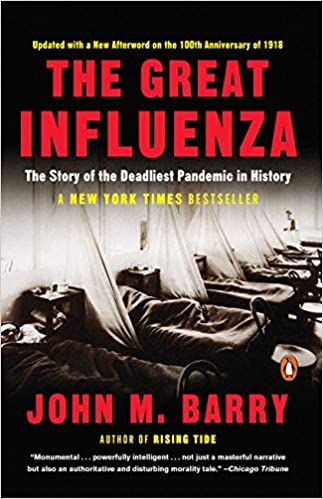
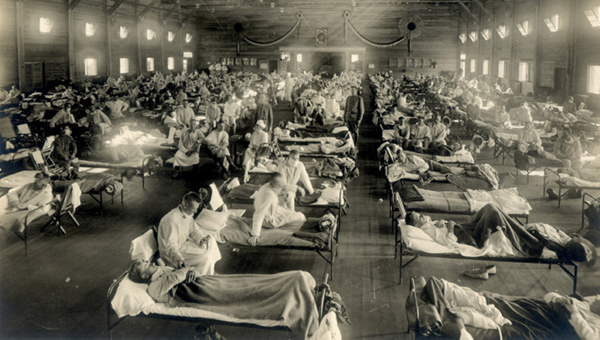
Beds with patients in an emergency hospital in Camp Funston, Kansas, in the midst of the 1918 influenza epidemic. The flu struck while America was at war, and was transported across the Atlantic on troop ships. Photo: Otis Historical Archives, National Museum of Health and Medicine.
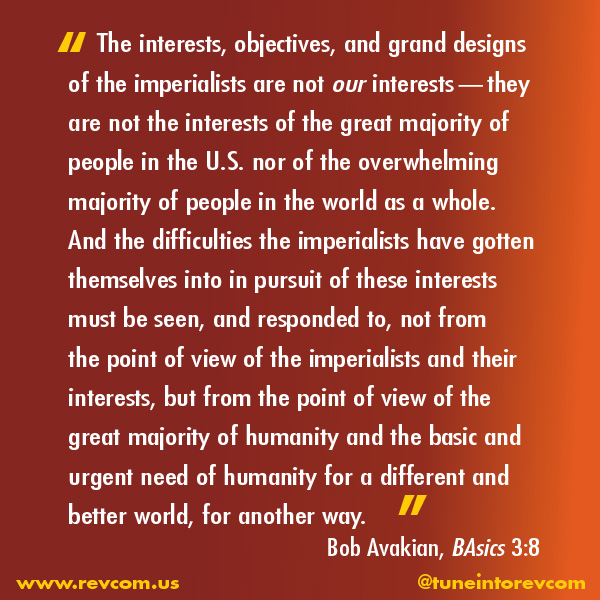
BAsics, from the talks and writings of Bob Avakian is a book of quotations and short essays that speaks powerfully to questions of revolution and human emancipation.
“You can't change the world if you don't know the BAsics.”
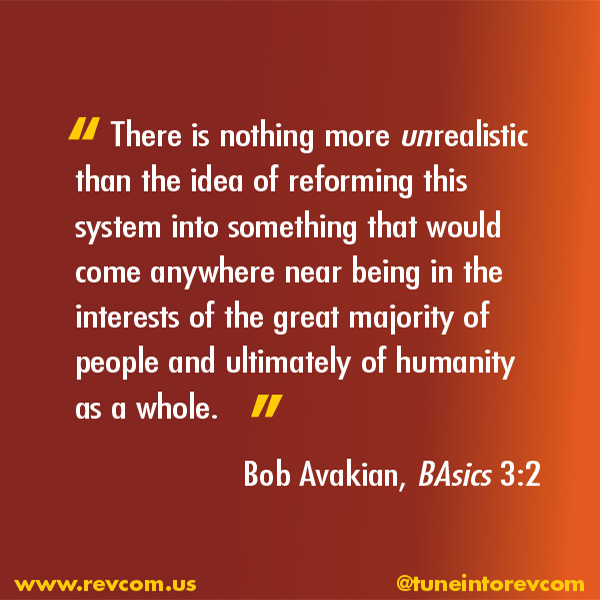
Get a free email subscription to revcom.us:


